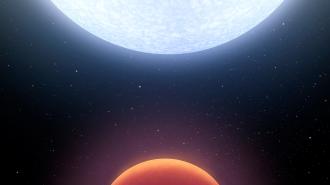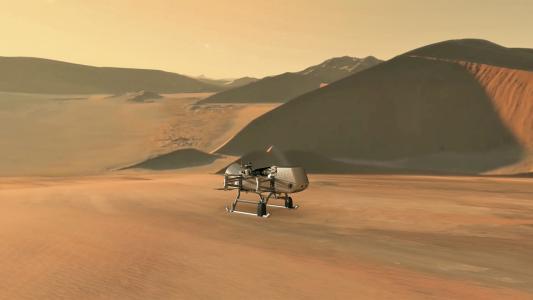Alright!
Listen up, you Silicon Valley unicorn wranglers, you cobra-hearted capitalists, you old boarding school, blue-blooded, Mayflower-money types, because Scott Gaudi has a deal for you. The return on investment may take a few decades, granted, but it will be historical, your hagiography sealed amongst the stars: give the Ohio State astronomer and exoplanet hunter a few billion dollars, and he’ll find you signs of extraterrestrial life.
Across the world of exoplanet discovery and the search for ET, a consensus is building: finding a definitive sign of alien life is not a pipe dream. The technology has mostly been developed, and a diverse array of scientists — astronomers, astrophysicists, earth scientists, and astrobiologists — are feverishly working on identifying habitable exoplanets, a major step toward finding signs of actual habitation.
First discovered only in 1992, exoplanets, which orbit stars outside our solar system, range from small, rocky planets like Earth to massive, smoldering “Hot Jupiters.” (KELT-9b, discovered by Gaudi and colleagues in 2017, is a type specimen of a new class called “Ultra Hot Jupiters,” with a daytime temperature around 7800℉ — hotter than most stars!)
Big exoplanets are easier to find, but we now know, thanks to NASA’s Kepler Space Telescope, that small, potentially habitable exoplanets are common, Gaudi says. Earth-like planets may be orbiting as many as 1 in 4 sun-like stars. This imagination-juicing discovery is one of the major developments in the last decade that are changing the field.
The hardest part of exoplanet discovery is blocking the light from those stars to see their planets. Cutting edge tools, like the coronagraph and the awe-inspiring starshade, could solve that problem in the near future.
And already, the search for proof of extraterrestrial life is being aided by new tools and discoveries. Computer simulations can see into a planet’s future until its star burns out. Satellite devices can tease out an exoplanet’s atmospheric composition. A new space telescope era is about to begin, and key insights are being gleaned from the billions of years of life on Earth.
“If HabEx started getting funding now, we could launch it in something like 2030. And if life were abundant, we would find evidence of it within a few years.”
Scott Gaudi, American Astronomer
If one of the new orbital telescopes that has been fine-tuned to find life (LUVOIR or HabEx) is chosen as the next major mission, we may make the most monumental discovery in human history within your lifetime.
“If HabEx started getting funding now, we could launch it in something like 2030,” says Gaudi, who works on the HabEx project.
“And if life were abundant, we would find evidence of it within a few years.”
Coal-town Dreams of Life on Other Planets
Born in Beirut to American parents, Gaudi’s family fled the Lebanese Civil War. Baby Scott floated around the U.S. and UAE before ending up in small-town Illinois at age 6. An intellectual, bored-to-bad-grades kid in an old coal town, Gaudi can trace his desire to find extraterrestrial life to his second grade science teacher.
“One day she did something that changed my life,” Gaudi says. “She told our class to go and memorize the names of the nine planets — back when there were nine — in order of distance from the sun.”
Gaudi’s supportive parents had a subscription to National Geographic, which came with picture atlases. Plucking Our Universe from the shelf, Gaudi memorized our solar system. But what really caught him was a more speculative section in the back.
“There was a chapter on what life might be like in other places in the solar system,” Gaudi says. There were “Jovian Johnny Weirs,” radiation-sucking beings who skate across the icy surface of Europa. Bizarre “oucher-pouchers” from Venus, which look like gator-skin basketballs, must hop from one leg to the other to bounce across the scalding surface of Venus. Grotesque Goodyear Blimp creatures, like parachuting Cthulhu heads, ply the endless skies of Jupiter.
“I just thought the whole thing was just amazing,” Gaudi says.
The proof of oucher-pouchers beyond our sun will be indirect, Gaudi says. An exoplanet is simply too far away for a probe to bring back a specimen. Finding this evidence is Gaudi’s specialty.
“The smoking gun is disequilibrium chemistry,” Gaudi says. Certain atmospheric compositions are most likely caused by life. Have a ton of oxygen and a bunch of hydrogen floating above your possibly habitable exoplanet? Something needs to cause that disequilibrium, and life could be it.
Transit spectroscopy can tell researchers like Gaudi what a planet’s atmosphere is made of. When an exoplanet passes in front of its star, the light from the star will dim ever so slightly, which astronomers can use to determine the size of the planet.
That dip in brightness is caused, in part, by starlight filtering through the planet’s atmosphere and being absorbed by different molecules. When this light is split like a prism, researchers can see what colors of light are missing from the spectrum, allowing them to infer what the atmosphere is made of — water vapor, oxygen, methane, or whatever else.
But what is an exoplanet with life going to look like?
Looking for Earth-like Planets? Start With the Real Deal
To find a planet we can be reasonably sure supports life, it’s best to start at home — beneath our feet, above our heads, in our lungs, and all around us. The Earth can contribute to habitable exoplanet discovery by informing the search for new candidates. It’s a wealth of knowledge that does not require a new space telescope to gather.
“I think there’s a lot of value in studying the history and emergence of life on our own planet,” says Stephanie Olson, a postdoc at the University of Chicago studying earth history and astrobiology. Studying the chemical compounds in the Earth’s rocks and the fossil record will help tease out what combination of chemicals may support life on other planets.
“I feel privileged and honored to be able to participate in the scientific endeavor to answer one of humanity’s most profound questions: are we alone?”
Scott Gaudi, American Astronomer
The history of our planet can also provide models of what could be the most promising habitable exoplanets today. Over its 4.5-billion-year history, Earth has sported various atmospheres and surface conditions like a fashion montage: life as we think of it now, and the current conditions that support it, are little more than the opening notes to “Supermodel.”
For billions of years, before dinosaurs, before even animals and plants, the planet supported life. Earth-like planets mimicking these earlier, “alternate Earths” are just as viable a candidate for life as planets which resemble our current iteration. This widens the scope of the possibilities but still keeps the search criteria relatively narrow.
With those parameters, researchers like Olson can explore finding other possible “biosignatures” that she, Gaudi, and other hunters for extraterrestrial life can scour the universe for.
Exoplanet in a Computer
Exoplanets based on early Earth (or any other parameters an exoplanet hunter can dream of) can now be simulated in unprecedented detail — 10 billion years of revolutions, compressed into seconds. Entire solar systems can be plotted out and set in motion, their interactions laid out by powerful software.
Using simulations, Olson can better understand what may happen to the surface environment of habitable exoplanets. She can simulate the effects of conditions that are observable, like changes in the atmosphere, or conditions that are currently unobservable, like the salinity of surface water.
VPLanet, a simulator created by University of Washington astrobiologist Rory Barnes, allows researchers to customize a dizzying array of variables to create a bespoke exoplanet for their research.
Researchers can tweak the initial interior temperature of the planet, geological energy sources, the composition of the atmosphere, the amount of surface water, the speed of its rotation, the tilt of its axis, and the distance and shape of its orbit, among sundry details. Even its star’s location in the galaxy can be adjusted and simulated.
VPLanet essentially lets a scientist play deity. Want to rearrange our own solar system, just to see what happens? Sure! Pop Jupiter in Venus’s orbit and watch the results. It is the ultimate galactic sandbox, and importantly, VPLanet is open source and available for anyone to use.
“I think that the discovery of alien life will be a transformational event in human history,” Barnes says. “And I want it to be clear that when we go to the public, that we have come to this conclusion through open science, through a process that has been vetted by the community, and that there can be confidence that this is a true result.”
To get that result, though, Gaudi’s going to need his money.
A New Space Telescope Fine Tuned for Finding Extraterrestrial Life
Two potential NASA projects would put exoplanet discovery and research front and center. The space telescopes HabEx — which Gaudi and a team of around 180 people helped research and propose — and LUVOIR are our best bets for actually seeing potentially habitable exoplanets.
The telescopes would use two different devices, the coronograph and the starshade, to block out the starlight that usually overwhelms images of very dim and distant planets. The LUVOIR design relies on a coronograph to block out the light (kind of like how the moon allows us to see the sun’s corona during an eclipse).
Far more dramatic, the awesomely named “starshade” is a foldable shield, 50 meters across, which unfolds like a flower and flies to a precise spot 100,000 km away from the space telescope, blotting out all other light sources near the telescope’s target. Starshades are a little sensitive: they can only be one millimeter off from perfectly flat, the edge must be honed down to one micron, and they have to be maneuvered within one meter of their target position. (Suffice to say, they currently exist only as small-scale models.)
But both HabEx and LUVOIR are specifically designed to find signs of life.
The Dream: Extraterrestrial Life in Our Lifetime
The field has changed in the past decade, Gaudi says. We now know there are more of these potentially habitable exoplanets out there than expected; we now know more about how the stars they orbit impact our ability to study them; and we have recently developed the technology to tackle those challenges.
Stepping into this new period of discovery are budding scientists who have grown up in the exoplanet era. For them, the potential of extraterrestrial life on planets like Earth is not a fever dream.
Two potential NASA projects would put exoplanet discovery and research front and center.
The earth-like planets are out there. The technology is here or extremely close. The scientists with the knowledge, desire, drive, and passion — the passion of a small kid in coal country, who found his calling in fantastical creatures on distant worlds — are ready.
“This might sound a bit corny,” Gaudi says, self-consciously, “but primarily I feel privileged and honored to be able to participate in the scientific endeavor to answer one of humanity’s most profound questions: are we alone?”
What is needed to answer that question is capital and political will.
Selecting a habitable exoplanet mission could very soon yield one of the most monumental discoveries in human history, a realization which would have impossible to predict implications.
“I think the time is now to do this,” Gaudi says.
“If we can do it now, we should do it. We should take that first step.”




